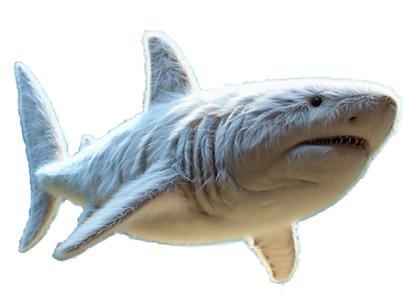FREE Shipping Over $55! $4.99 Flat Rate Shipping.
A portion of every purchase goes towards supporting Shark Conservation.
TM
Rethinking & Saving Sharks Through Art


OUR STORY
Dive into the origins and evolution of Fuzzy Sharks, from concept to creation, and explore our journey in raising awareness about shark conservation.
OUR STORY
Artist and Ocean Advocate Jessica Adanich created the Fuzzy Sharks (patent pending) art installation as a way to educate and inspire individuals to care about sharks. Fuzzy Sharks is just one of many art pieces that Jessica has created to promote shark conservation. This classic and popular installation has become Jessica’s campaign name for her work. She hopes to educate, inspire and create action for our shark species.
The Art Installation Fuzzy Sharks

What is the actual Fuzzy Sharks installation all about?
Biophilia is a well-documented phenomenon that suggests through culture and experience, humans are attracted to certain physical elements in order to sustain biological evolution. The term “biophilia” is defined as the “love of life or living systems.” In our society, sharks have received the wrong impression due to their appearance and bad reputation perpetuated in popular culture and media. Though sharks have been alive for more than 400 million years their populations have declined drastically due to human actions over the last three decades. It is estimated that 100 million sharks die each year due to bycatch, longline fishing and finning.
Fuzzy Sharks uses art as a vehicle to bring conservation issues to light while challenging people to engage on a deeper level. People absorb information in a variety of ways including those that are visual, tactile and often unconventional. In particular, children learn mostly through tactile or kinetic learning. This type of learning through hands-on experience involving touch, movement, and interaction allows them to engage all of their senses, thereby, activating their minds. It is crucial that children grow up with a deep appreciation for the oceans to ensure their survival. To test the effectiveness of the biophilia connection between humans and sharks, an exhibit displaying a shiver of sharks dressed as soft-textured, approachable animals was installed. The shark bodies themselves were weighted to give the impression these bodies were real. The viewer could walk in and around the hanging sharks, allowing them to touch and fully experience the exhibit. The purpose of this installation is to invite the viewers to question their attitudes towards sharks. It is easy to justify protecting or saving an animal perceived as “adorable”, such as polar bears, puppies, or chimpanzees. Features such as oversized eyes and ears, along with a soft fur texture, instantly appeal to humans. Viewers had an instant “aha” moment in the installation once they realized the fur covered forms represented sharks. The soft textured bodies created an emotional connection. The message perpetrated through the exhibit struck viewers more strongly than just stating, “Sharks are important. We should protect them.” The result was an increased awareness of the importance of sharks and awareness of the viewer’s own negative perceptions.
In conservation, the first step to creating action is to create awareness. Population control via natural predatory hierarchy and overall oceanic health depends on this misrepresented animal. As an apex predator, sharks are crucial to maintaining a balanced ecosystem. A depletion of any one species, throws off the equilibrium, which, in turn, will not only affect the oceans, but humans as well. This installation combined with educational materials, lectures, marketing and media is the heart of what Fuzzy Sharks does. It is education up close. By combining art and science, an unforgettable experience is created in which viewers are more likely to walk away contemplative, having truly seen rather than just looked.